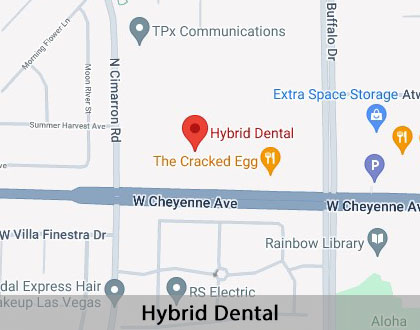Dental Sealants Las Vegas, NV
Dental sealants are thin plastic coatings that cover uneven tooth surfaces to protect them from tooth decay and cavities. They usually go on the premolars and molars, where tooth decay is the most common. These coatings are a simple and effective way to protect children's teeth.
Do not hesitate to protect teeth from decay and damage. Our team at Hybrid Dental offers dental sealants in Las Vegas and the surrounding area. Call us today at (702) 628-5807 to learn more about our services or schedule an appointment.
The Details About Dental Sealants
Dental sealants are thin plastic that is bonded to the tooth surface as additional protection again tooth decay. This protective coating helps keep bits of food out of the grooves of the teeth and stops bacteria and acid from settling there. According to the American Dental Association, sealants prevent 80% of cavities in the back teeth.
Dental sealants have been used successfully for more than 40 years and continue to grow in popularity. Research shows children who do not get sealants are more than twice as likely to get cavities than children who have sealants. The American Dental Association and the American Academy of Pediatric Dentistry recommend this procedure for all children.
“Dental sealants have been used successfully for more than 40 years and continue to grow in popularity.”
The Right Age For Dental Sealants
Children and adults can both benefit from dental sealants. However, the earlier a patient gets dental sealants, the better. Patients can receive dental sealants as soon as their permanent molars erupt. The first set of molars typically erupt around age six or seven, while the second set usually comes around age 12 or 13.
We recommend sealing these teeth as quickly as possible to help teeth remain cavity-free from the beginning. While dental sealants are usually best for permanent molars and premolars, some baby teeth may also benefit from sealants. Baby teeth with many grooves are more susceptible to decay and may require dental sealants to protect them from decay and premature tooth loss.
“Patients can receive dental sealants as soon as their permanent molars erupt.”
The Advantages and Disadvantages
In addition to their protective properties, dental sealants have longevity and durability. Research has shown they prevent 80% of cavities for two years after application and continue to protect against 50% of cavities for up to four years. Sealants can even stay in the mouth for as long as nine years.
There are some disadvantages. Children may need to have sealants reapplied if they fall out, chip, or wear away. Dental sealants can get chipped or worn when a patient bites into hard food or eats too much food with high acidic content. It's best to keep a close eye on what a child with sealants consumes, especially right after the sealant is applied. A patient's bite can feel slightly off after application due to the extra layer on the tooth, but this is temporary. During a regular dental visit, we will check the sealant's condition and reapply them as needed. Sealants need to be monitored and maintained during routine visits to ensure they do not wear away.
“In addition to their protective properties, dental sealants have longevity and durability.”
Check out what others are saying about our dental services on Yelp: Dental Sealants in Las Vegas, NV
The Application Process
The process of applying dental sealants is quick and painless. Before we can apply the sealants, we must first thoroughly clean and dry the tooth. After, an acidic gel roughens the chewing surface of the tooth to roughen it up.
The roughened surface will create a stronger bond between the tooth and the sealant. Once the tooth is rinsed and cleaned, we will apply the sealants to the tooth enamel and harden it with a curing light. The entire process of applying a dental sealant to a tooth only takes about one minute.
“The entire process of applying a dental sealant to a tooth only takes about one minute.”
Questions Answered on This Page
Q. What are dental sealants? Are they growing in popularity?
Q. What are some of the advantages and disadvantages of dental sealants?
Q. What does it feel like after sealants are applied?
Q. What's the right age to get sealants?
Q. What is the application process for dental sealants?
People Also Ask
Q. What are composite fillings?
Q. What is involved in the dental cleaning portion of a checkup?
The Post-Sealant Experience
There may be some slight discomfort when the sealants are first applied as the child gets used to having an additional layer of material on their back teeth. Some children complain of a feeling of not being able to fit their back teeth together. The thin film will feel like it's a part of the actual tooth within a day or so.
Other reactions include complaining of an odd taste immediately after sealant application. Usually, a good rinse or a sip of a flavored drink will help eliminate the taste. Our team will help address any issues or concerns after the sealants are applied.
“There may be some slight discomfort when the sealants are first applied as the child gets used to having an additional layer of material on their back teeth.”
Frequently Asked Questions
Q. Are dental sealants safe?
A. Dental sealants are safe and effective for patients. While some people may be concerned about bisphenol A (BPA) exposure, according to the American Dental Association (ADA), the amount is so minimal that there is no health concern. Patients get more exposure from food, drinks, sunscreen, and cosmetics.
Q. Do dental sealants hurt?
A. Getting a dental sealant does not hurt. Patients may notice the dental sealants on their teeth at first. However, this is temporary as people will adapt to the new feeling and not notice them anymore.
Q. How should I take care of my sealants?
A. Brushing and flossing remain important even when sealants are present. We also recommend that patients avoid chewy, sticky, or hard foods and snacks. Patients with sealants should also have regular dental check-ups to ensure that they are still effective and do not need replacing.
Q. Are there any side effects associated with dental sealants?
A. No. The only known side effect associated with dental sealants is an allergic reaction to the sealant material. This allergy is not common, but patients can have an allergy test beforehand as a precaution.
Q. How do dental sealants look on teeth?
A. Dental sealants are thin plastic coatings that help smooth out the rough surfaces of back teeth. They can be clear, tinted, or white. While sealants can be visible on teeth, they are not usually visible since they are at the back of the mouth.
Dental Terminology
Helpful Related Links
- American Dental Association (ADA). Glossary of Dental Clinical Terms. 2024
- American Academy of Cosmetic Dentistry® (AACD). Home Page. 2024
- WebMD. WebMD’s Oral Care Guide. 2024
About our business and website security
- Hybrid Dental was established in 2012.
- We accept the following payment methods: American Express, Cash, Check, Discover, MasterCard, and Visa
- We serve patients from the following counties: Clark County and Nye County
- We serve patients from the following cities: Las Vegas, Summerlin, North Las Vegas, Spring Valley, Paradise, Henderson, Centennial Hills, Mt Charleston, Enterprise and Pahrump
- National Provider Identifier Database (1306143847). View NPI Registry Information
- Healthgrades. View Background Information and Reviews
- Norton Safe Web. View Details
- Trend Micro Site Safety Center. View Details
Back to top of Dental Sealants















